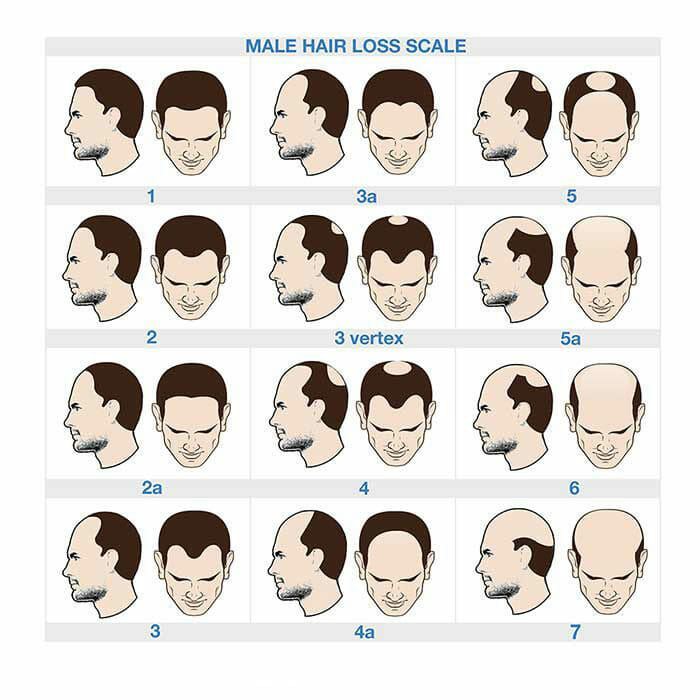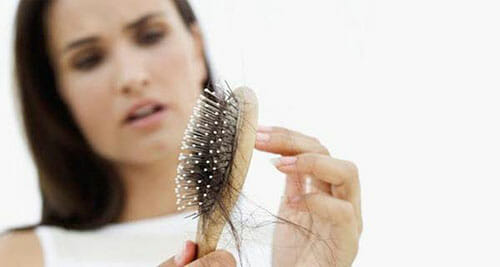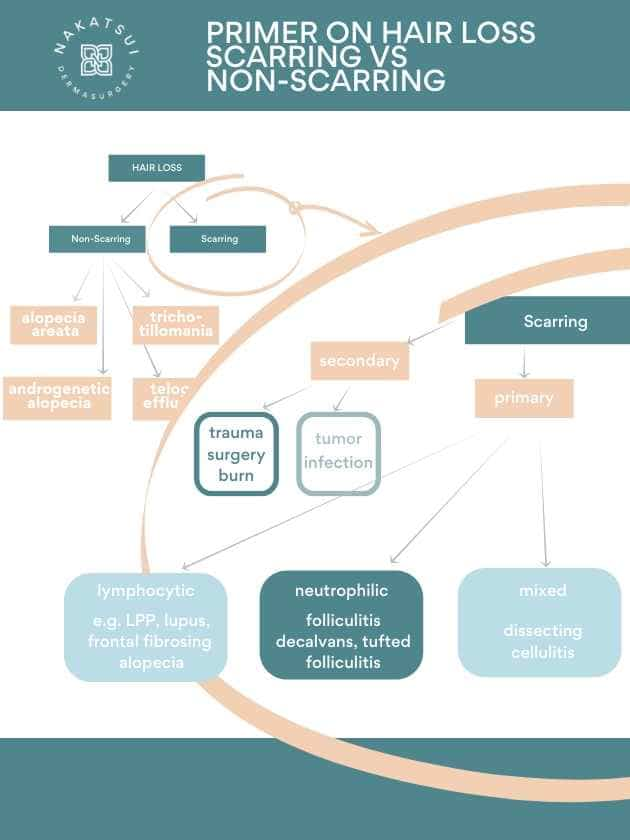Male Pattern Baldness / Female Pattern Hair Loss

Androgenetic alopecia, usually referred to as “male pattern baldness” or “female pattern hair loss”, is the most common cause of thinning in men and women. Hair follicles of men and women affected by this type of hair thinning are sensitive to naturally occurring hormones.
In men, the biggest culprit is called dihydrotestosterone (DHT). Exposure to this hormone will eventually cause the hair follicles to weaken. As the follicles shrink, the hair becomes finer, grows more slowly, and may ultimately disappear. Hair loss from androgenic alopecia will continue throughout a person’s lifetime; however, the rate of hair loss will depend on the inherited tendencies of each individual.
Fortunately, hair follicles at the sides and back of the head are not sensitive to DHT and will continue to grow for the person’s lifetime. Consequently, at our hair restoration centre in Edmonton, we can transplant these hairs to areas of hair loss, and once transplanted, these hairs will continue to grow for as long as the hair at the back of the head continues to grow. Using FUE and FUT techniques, we can rejuvenate and restore a receding hairline or fill in a balding crown.
What is the Norwood Scale?
The Norwood classification is the most commonly used classification of male pattern balding. There are limitations to the classification system but it remains the most commonly used system today. It was developed by a dermatologist, Dr. O’Tar Norwood.


In women, the situation is a little more complicated. DHT does not seem to be the biggest culprit and there are a large number of other hormones to consider. In some women, female pattern hair loss occurs when, due to a hereditary predisposition, the hair follicles are overly sensitive to normal male hormone levels and effectively burn out. Less commonly, male hormones may be in excess.
There are many genes and hormones involved in this type of balding, and in some cases, it can be impossible to pin down the precise cause. There is also a test called HairDX that looks for a gene that is related to male pattern hair loss. Unfortunately, it is not exceedingly accurate.
One myth is that the balding genes only come from one side of the family but the truth is that it come come from either the mother’s or the father’s side of the family. So just because your father and his father had an excellent head of hair, it does not mean that you are guaranteed to have great hair!

Other Causes of Hair Loss
Besides androgenic alopecia, there are many other causes and Doctor Nakatsui made this infographic to show some of the possible types of alopecia that dermatologists deal with all the time. Thyroid abnormalities, low iron stores, or hormonal imbalance such as high or even low testosterone may cause hair loss in some patients. The effect of these imbalances can be thought of as a type of telogen effluvium. Therefore it may be important to check for these conditions before embarking on a course of treatment if the diagnosis is clinically unclear.
There are two main subcategories of hair loss: scarring and non-scarring.
Some causes of non-scarring hair loss include alopecia areata (which is a fairly common non-scarring type of hair loss), trichotillomania, and telogen effluvium (stress induced hair loss). Alopecia areata is extremely common, presenting as focal patches of hair loss, although it can present in other patterns (diffuse, totalis, universalis, ophiasis, etc.)
Some common causes of scarring alopecia include lichen planopilaris, discoid lupus, folliculitis decalvans, and frontal fibrosing alopecia. Lichen planopilaris and frontal fibrosing alopecia are frequently missed diagnoses.
Traction alopecia is interesting because it is a biphasic phenomenon: non-scarring in the beginning and scarring at the end. The scarring eventually develops as a result of sub-clinical inflammation and trauma.
On occasion, these problems can be managed with hair transplants but careful consideration of the risks and limitations need to be discussed before proceeding with surgery.
Other treatment options include injections of cortisone, oral medications, and PRP in some cases.
The potential for regrowth of this hair depends on the cause of the hair loss and the type of treatment.
If you are unsure which type of hair loss you have, make an appointment with your dermatologist.
- Dr. Thomas Nakatsui, Nakatsui DermaSurgery
- Dr. Eric Schloss, Nakatsui DermaSurgery
- Dr. Fatmah Alzaharani, Rao Dermatology/Alberta Dermasurgery Centre, Edmonton
- Dr. Eunice Chow, Kaye Edmonton Dermatology Clinic
- Dr. Marlene Dytoc, Kaye Edmonton Dermatology Clinic
- Dr. John Elliott, Kaye Edmonton Dermatology Clinic
- Dr. Andrew Ferrier, Stratica Medical, Edmonton
- Dr. Loretta Fiorillo, Kaye Edmonton Dermatology Clinic
- Dr. Mariah Giberson, Stratica Medical, Edmonton
- Dr. Robert Gniadecki, Kaye Edmonton Dermatology Clinic
- Dr. Parbeer Grewal, Rejuvenation Dermatology, Edmonton
- Dr. Matthew Karpman, Rejuvenation Dermatology, Edmonton
- Dr. Chris Keeling, Symmetry Dermatology, Edmonton
- Dr. Anil Kurian, Vida Dermatology, Edmonton
- Dr. Tiffany Kwok, Rao Dermatology/Alberta Dermasurgery Centre, Edmonton
- Dr. Maninder Longowal, Rejuvenation Dermatology, Edmonton
- Dr. Chuck Lortie, Park Dernatology, Sherwood Park
- Dr. Neel Malhotra, Skin Physicians, Edmonton
- Dr. Mathew Nicholas, Edmonton Dermatology and Skin Surgery Centre
- Dr. Jaggi Rao, Rao Dermatology/Alberta Dermasurgery Centre, Edmonton
- Dr. Thomas Salopek, Kaye Edmonton Dermatology Clinic
- Dr. Mariusz Sapijaszko, Youthful Image, Edmonton
- Dr. Michael Samycia, Symmetry Dermatology, Edmonton
- Dr. Michael Sawchuk, Vida Dermatology, Edmonton
- Dr. Gordon Searles, Searles Dermatology and Aesthetics, Edmonton
- Dr. Ali Shabhaz, Stratica, Edmonton
- Dr. AnneLiese Smylie, Symmetry Dermatology, Edmonton
- Dr. Laura Soong, Edmonton Dermatology and Skin Surgery Centre
- Dr. Muba Taher, Edmonton Dermatology and Skin Surgery Centre
- Dr. Zaki Taher, Lucere Clinic, Edmonton
- Dr. Zohair Tomi, Tomi Derma, Edmonton
- Dr. Trang Vu, Stratica Medical, Edmonton
- Dr. Norm Wasel, Stratica Medical, Edmonton
- Dr. Eric Wong, Rejuvaderm, Edmonton
- Dr. Russell Wong, Rejuvenation Dermatology, Edmonton
Scars and Refinement of Previous Surgery
With hair transplantation, we are not only able to treat male pattern baldness and female pattern hair loss, but we are also able to refine previous transplant surgery. There are many people out there who have undergone previous hair restoration surgery using cruder methods that may have resulted in an unnatural appearance that is relatively obvious, even to the untrained eye. Thankfully, using advances in hair transplantation, these transplants can be fixed! Usually, just one session using follicular units can transform an unacceptable appearance into a natural looking head of hair. Dr. Nakatsui has helped many patients who have had obvious transplants in the past.
Hair transplants can also be used in other areas of hair loss, such as the beard or eyebrows. Some patients are born with patchy hair in the beard or eyebrow area and want to improve their appearance. Others have scars in these areas and just want to restore their appearance or hide the scars. Beard hair transplants have become very common in the recent past.
Dr. Nakatsui has also helped many patients who have scars from previous surgery. Patients who have had neurosurgery or plastic surgery often have scalp scars. For example, face lifts often leave areas of hair loss above or in front of the ears and these areas can be filled in, particularly with the technical advances that have been have been made over the last few years in hair restoration surgery. Linear scar lines from previous hair transplants can also be filled in with FUE. Unfortunately, most people are just unaware that something can at last be done.
Can these types of baldness be cured?
Some types of baldness can be cured but other types cannot. There are many types of alopecia and they can sometimes look very similar. However, that are all different and require different treatment approaches. See a dermatologist (skin and hair loss expert and specialist) to find out what type of hair loss you suffer from and to determine the best treatment.
